Alligators of Brazil
Alligators and crocodiles are physically very similar. They are usually seen as large, slithering reptiles with a huge mouth full of teeth ready to bite anything that comes their way. But there are some easy ways to tell them difference: alligators have a wider snout than crocodiles, and most of the time only the upper teeth are visible when the mouth is closed. Also, crocodiles are not part of the Brazilian fauna.
There are only four genera of alligators in the world, one of which is the Alligator, with one species in North America and one in China. In Brazil and other South American countries there are three genera — Melanosuchus (one species), Paleosuchus (two species) and Caiman (three species).
Black caiman (Melanosuchus niger)
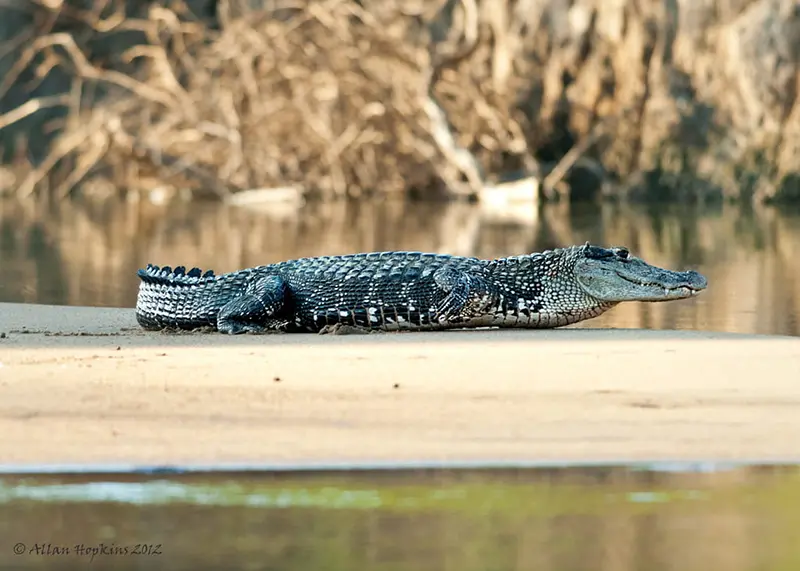
The black caiman is the largest species in Brazil, with males reaching about 4 m (13 ft), but some individuals have been found to reach 6 m (20 ft) - the females, however, are usually smaller, not exceeding 3 m (10 ft). As with all species of alligator, juveniles are born with a conspicuous yellowish color that darkens as they grow.
As a large reptile, it is at the top of the food chain and can feed on any animal in its habitat, such as fish, capybaras , deer , and sloths. The only animals that can kill a black caiman are jaguars and anacondas - and even then, only the smallest and youngest individuals can be killed.
Female black caimans nurse their young for several months, but because they are born large and almost independent, most do not survive to adulthood.
In Brazil, the black caiman is found in the northern and central regions, but 70% of its population lives in the Amazon Basin. The species is also found in Colombia, Bolivia, Ecuador, Peru and the Guianas.
Broad-snouted caiman (Caiman latirostris)
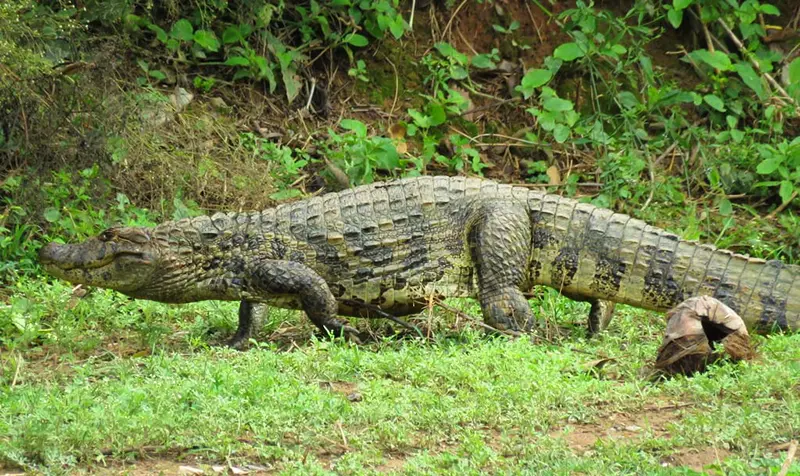
Although the maximum reported size of a broad-nosed caiman is 3.5 m (10 ft), they rarely exceed 2.5 m (8 ft). Their coloration is usually olive green with black stripes, becoming darker as they age. This pigmentation has excellent mimetic functions, making them almost invisible among the vegetation.
They also have the widest snout of any caiman, an adaptation that allows them to cut through the dense vegetation of swamps and break up turtle shells. As a result, they end up swallowing some of the vegetation as they search for food.
Surprisingly, the broad-snouted caiman feeds mainly on snails and other mollusks, and is a great controller of the pests that transmit schistosomiasis - especially when young. Other reptiles, mammals, fish and birds are also part of their diet.
During the first year of life, young remain close to their birthplace and are cared for by both parents.
The geographic distribution of the species seems to follow the main river basins of the Paraná and São Francisco rivers. However, human factors have altered its distribution, as some stretches of these rivers have been dammed to create hydroelectric dams, and large areas have also been drained for agricultural purposes. In addition, pollution is a major problem in the rivers that flow through Brazil’s major cities.
Although threatened by urbanization, the broad-snouted caiman can be seen in some rivers and lakes in cities such as Rio de Janeiro, Belo Horizonte, Florianópolis, and São Paulo. It is also less common in the salty and brackish waters of mangroves and coastal islands in southeastern Brazil.
Spectacled caiman (Caiman crocodilus)
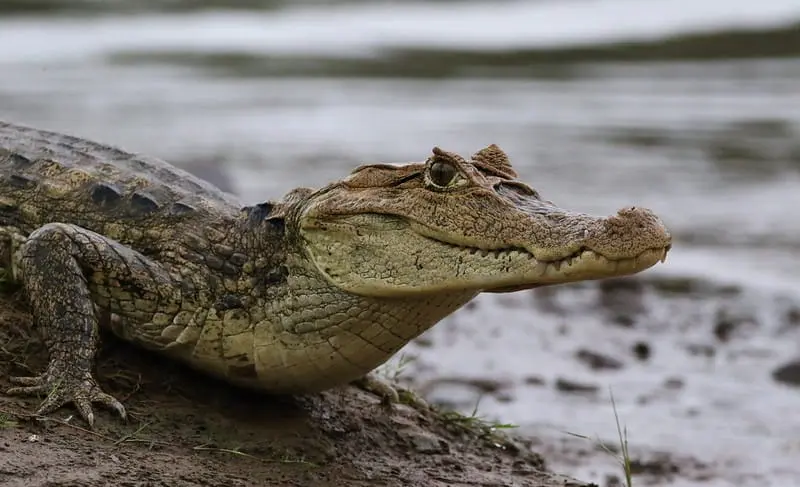
It gets its name from the bony ridge between its eyes, which looks like the structure of a pair of glasses. It is also known as the white caiman, probably because some individuals have a more opaque back. Despite its name, the spectacled caiman can change color depending on the season - during cold seasons, the black pigment in its skin expands, making it appear darker.
The spectacled caiman is a medium-sized alligator, growing to 2.5 meters. Research on their feeding habits shows that they can adapt their diet to the season: during the rainy season, they prefer snails and freshwater crabs; during the dry season, they feed mainly on fish.
The caiman can use up to nine different vocalizations and 13 visual displays to communicate with individuals in its group, such as alarm calls, distress calls (used by juveniles), and group rally calls. Males also communicate by tail movements and low-frequency vibrations that are strong enough to move water.
Females raise their own young and those of several others, forming small “nurseries”. Young spectacled caimans are the slowest to become independent, requiring the care of their mother for up to 18 months.
Adult populations of this species are estimated in the millions and are therefore stable. Due to its ease of adaptation and wide distribution, habitat reduction does not significantly affect the species. It is also tolerant of hunting, as its leather is not as commercially valuable. In addition, hunters generally prefer large males, which partially reduces the risks of hunting. The spectacled caiman also benefits from the hunting of competing species that live in the same habitat, gaining food that would normally be lost to other species.
Yacare caiman (Caiman yacare)
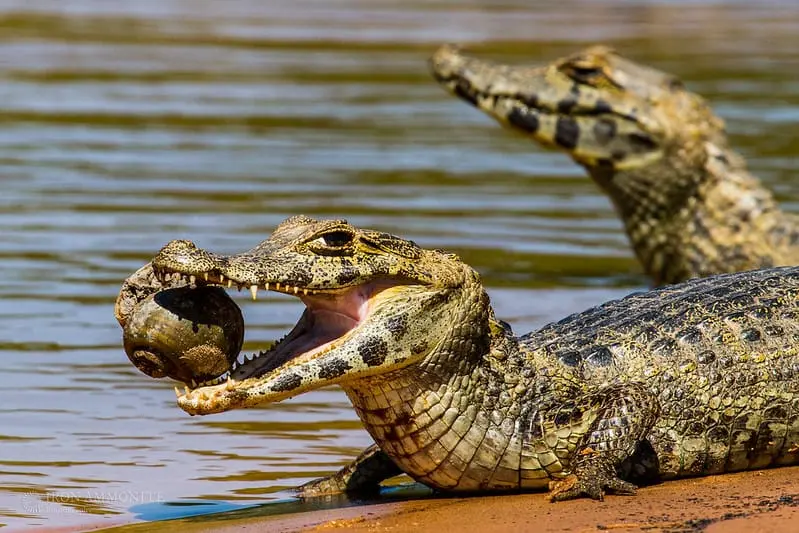
It usually reaches 2 m (6.6 ft), but larger specimens have been found. In adults, the back is usually dark, with yellow transverse stripes on the legs, lower jaw, and tail. Some of the teeth in the lower jaw can pierce the holes in the upper jaw, which is why it is also known as the “piranha caiman,” but this characteristic is not uncommon in other alligator species, especially in older individuals.
It feeds on snails, crustaceans and fish - being the main predator of piranhas. When necessary, it may occasionally prey on other reptiles and small mammals. Like the caiman and the broad-snouted caiman, it also uses movements and strong vibrations to communicate with other members of the group. This allows them to show dominance and attract the attention of females.
Females usually mate with more than one male, which makes their offspring larger and increases their survival rate, as the young are born independent and receive little help from their parents - making them more vulnerable to predators. It is one of the most abundant species on the continent. In the Pantanal, there are an estimated 35 million Yacare caimans, with 150 animals per square kilometer, the largest concentration of reptiles on the planet.
Smooth-fronted caiman (Paleosuchus trigonatus)
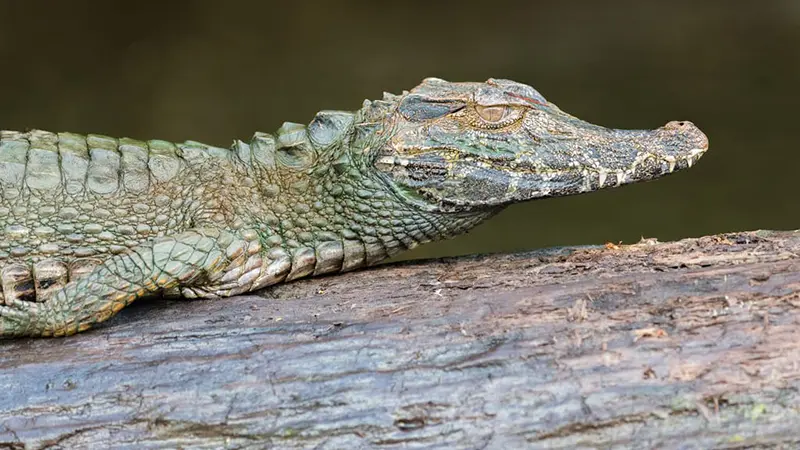
Also known as Schneider’s dwarf caiman. It is found in small streams, open water, and near waterfalls in the interior of the Amazon rainforest. It is the second-smallest alligator in the world, with males reaching only 1.7 meters (5 feet) — however, the largest individual ever found was 2.6 meters (6 feet).
Their diet is based on small reptiles, birds, and mammals, consuming few fish and mollusks.
The smooth-fronted caiman have large, sharp triangular shields on the back of their necks and tails, and tend to walk with their heads up and their necks tilted up to aid in defense. In addition, their tails are so well armored that they are practically inflexible.
They spend the day hiding in underwater burrows or as far as 100 m (330 ft) from the water; covered under dense vegetation, fallen trees, or inside hollow trunks. At night, they come out to patrol their territories along the waterways and feed.
The incubation period is about 115 days (the longest of any caiman), and the female remains near the nest for at least the first part of this time, providing protection from predators. When the eggs hatch, she transports them to a nursery and cares for them for only a few weeks, after which the young disperse.
The main threats to this species are habitat destruction and pollution of its environment by gold mining. Its skin contains many bony shields that make it not very useful for leather, and it is not usually hunted for its meat.
To date, there are no studies that evaluate its populations, mainly because of the difficulty in accessing its habitats. However, it is believed that the species has not suffered any major population decline in the country, and it is estimated that there are about one million individuals in the wild. The species is listed as least concern on the IUCN Red List of Threatened Species.
Cuvier’s dwarf caiman (Paleosuchus palpebrosus)
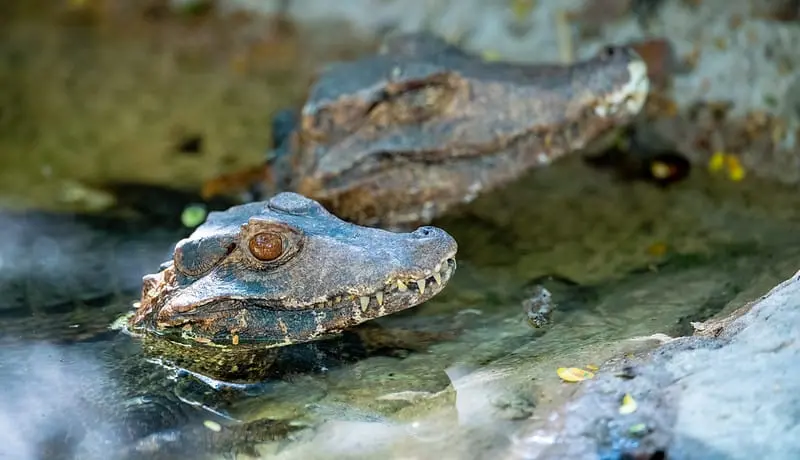
Cuvier’s dwarf caiman is the smallest caiman in the world, reaching only 1.5 meters (5 feet) in length. But its small size is partially offset by its hard armor, which protects it from predators.
It lives in riparian or flooded forests, near lakes and rivers. Like the Schneider’s dwarf caiman, it frequents fast-flowing streams and tolerates colder water than other caimans. They are nocturnal and solitary. Adults are generalists, feeding on fish, amphibians, birds, small mammals, shrimp, crabs, mollusks, and other invertebrates that they catch on land or in the water.
Newborns have a layer of mucus that keeps them moist. Until the mucus dries, the young have no need to enter the water. The female stays with the young for only a few weeks, then the young become independent and disperse.
Many alligators are hunted for their leather, but not the Cuvier’s caiman. Its skin is very armored, making it difficult to tan. On the other hand, gold mining can be a threat. Although their population numbers are unknown, they seem to be numerous in many of the places where they are found. On the Red List of Threatened Species (IUCN), the Cuvier’s caiman is listed as “least concern” because its range is extensive, covering much of northern, northeastern, and central-western Brazil.
Breeding
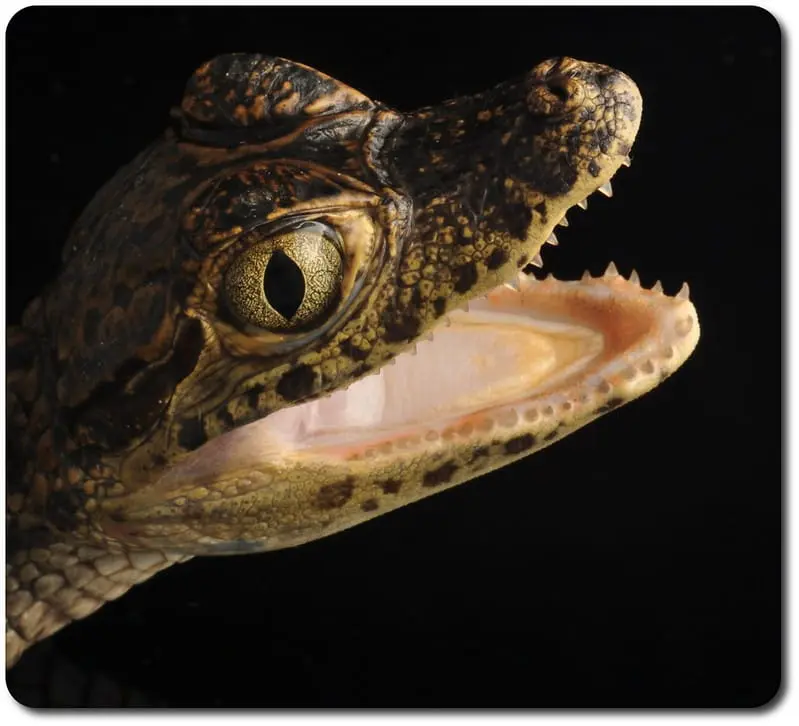
When it comes to reproduction, alligators have a lot in common: first of all, the reproductive period for all of them usually takes place during the summer, when the rain raises the water level. In addition, the females of the different species always stay close to their nests when they lay their eggs, guarding them from birds, mammals, and reptiles that might try to eat them. The temperature of the environment is also a common factor that determines how many females and males will hatch and must always be controlled by the females.
Eggs hatch in an average of 90 days. It is well documented that (as with many other species) when the young are born, the mothers remove them from the nest and use their mouths to carry them to a safe pool. Juveniles feed primarily on insects and small invertebrates. As they grow, they take larger prey.
Threats and Conservation
In the last century, many alligator populations were reduced or nearly extirpated due to hunting for leather and meat - in the 1950s, about 1,200,000 alligators were killed annually. Between 1950 and 1965, more than 7.5 million skins were exported from the state of Amazonas alone.
With the introduction of the Brazilian fauna protection law in 1967, hunting was reduced. Thanks to several conservation programs set up throughout South America, alligators have managed to recover and are now considered abundant, with little concern about their extinction.
Still, the Amazon is the largest illegal producer of alligator meat in the world. Black caimans are still hunted by local people to be used as bait for piracatinga fishing. In addition, it is estimated that 50 tons of alligator meat were sold in 2005 alone - the equivalent of about 5,000 individuals.
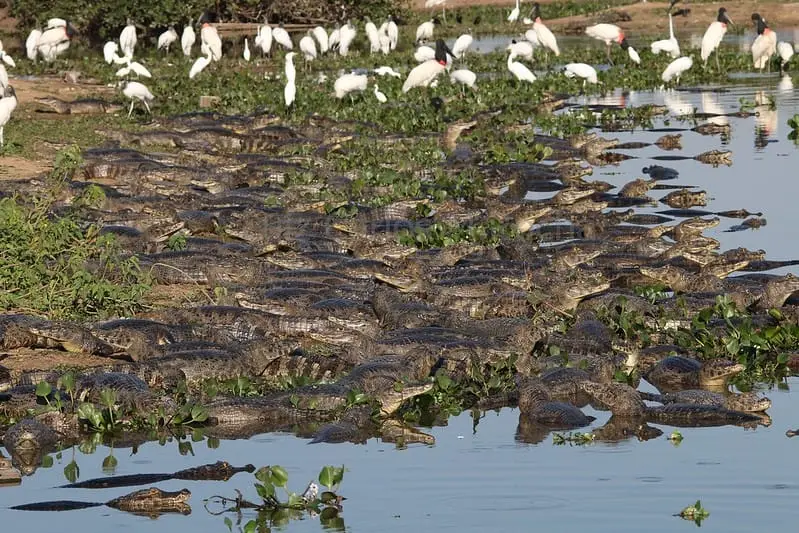
Broad-nosed caiman meat is often sold as “São Francisco codfish” in local markets in small towns along the São Francisco river basin in the northeast. In addition, the construction of dams and deforestation can also affect the conservation of these animals.
The importance of these large predators for the stability and functioning of ecosystems is well known. Given their long evolutionary history, there is no doubt that alligators and crocodiles have influenced the evolution and ecology of other life forms and their environment for more than 200 million years.
As such, their conservation depends on providing incentives for the maintenance of their populations and habitats, a willingness to accept management practices that allow humans and alligators to coexist, the development of research, and environmental awareness.
Read more:
Dinâmica e estrutura populacional do jacaré-açu (Melanosuchus niger) na Amazônia
Avaliação do risco de extinção do jacaré-açu Melanosuchus niger no Brasil
Broad-snouted Caiman Caiman latirostris
Spectacled Caiman Caiman crocodilus
Avaliação do risco de extinção do jacaré-coroa Paleosuchus trigonatus
Os sons surpreendentes do jacaré brasileiro América Latina Selvagem Discovery Brasil
